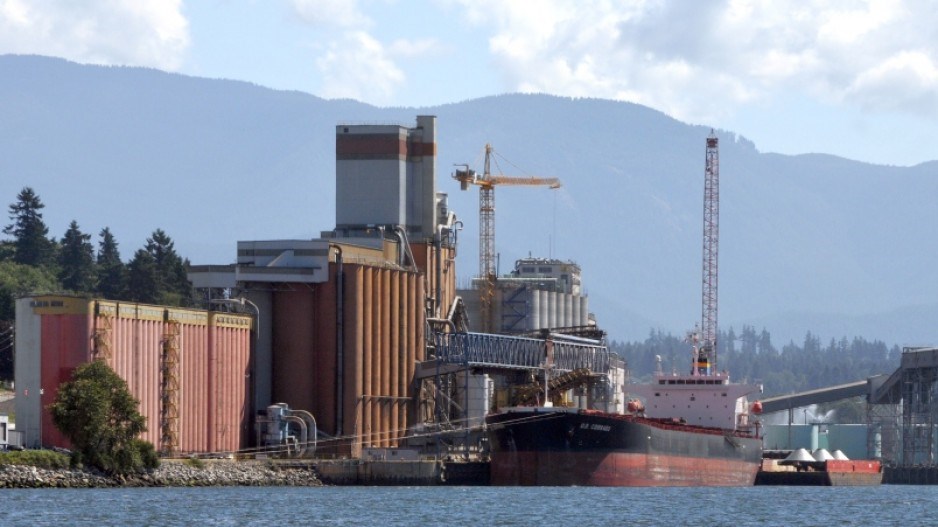For a port already dealing with congestion and traffic jams prior to this month’s “atmospheric river” rainstorm disaster, the cutting off of rail cargo links to Vancouver presents another major hurdle that provides few alternatives for a quick resolution.
The situation is especially problematic for operators of shipping vessels handling bulk cargo (i.e. grain, coal and potash), as these ships have little choice but to try to wait out the rail outages for their cargo to arrive at Port of Vancouver.
According the Port of Vancouver’s eHub data, as of Tuesday there are 65 vessels in the port – 23 at berth and 42 at anchorage awaiting a berth opening. Of those, there are now 21 grain-carrier vessels (5 at berths and 16 at anchorage) waiting to bring Canadian products to markets in Asia - as well as 12 coal vessels (1 at berth, 11 at anchorage) and 12 container ships (6 each at berth and at anchorage).
For most of these vessels, the options are to wait and to wait some more, said Trevor Heaver, professor emeritus at UBC’s Sauder School of Business and past president of the International Association of Maritime Economists.
“For the bulk trades, it is basically no options available,” Heaver said. “While there is always the exception – in the past, when lumber was a more prominent cargo, you might load some here and then top off in Washington state – the dominant trades now like coal, grain and fertilizers all have companies who chartered specific ships to carry specific cargoes from specific terminals.
“That means it’s very unlikely to take a rail movement of grain from Alberta and Saskatchewan that was going to route through Vancouver and route that movement to another port in the Pacific Northwest. It’s very hard to do.”
However, there are some exceptions – mostly with larger companies that have facilities at other ports, Heaver noted.
“Some bulk shippers do have a small relief valve,” he said, noting Teck Resources Ltd.’s coal exports and Canpotex’s potash shipments having alternative terminals at other ports. “Bulk shippers may be able to divert to these other terminals if these other terminals haven’t been going full-out already. I don’t know how much additional throughput those terminals could manage, although one would assume they’d be able to manage some.”
That is exactly the case with Teck, which confirmed it has rerouted some shipments of steelmaking coal to Prince Rupert’s Ridley Terminals. Canpotex, which has been exporting through a Kinder-Morgan operated terminal in Portland, Ore., in addition to Vancouver, is now also routing some shipments south of the border to avoid the blockage in southwestern B.C.
But even for bulk trades with multi-port alternatives and container ships – which routinely make calls at multiple ports along the west coast of North America and have more opportunities to unload at another port if Vancouver is closed – the solution of bypassing the Lower Mainland is a limited one.
That’s because the level of port congestion in the United States this year has been well-documented and unprecedented in its own right. Ports like Long Beach and Los Angeles have been so congested that they have implemented a queuing system requiring all incoming ships to wait about 150 miles (241 kilometres) off the California coast for berths to open.
Even as Long Beach sees limited capacity at its terminals, volume last month still managed to hit second-busiest of all time for October (bested only by October 2020), and 24/7 operations have been continuing for some time.
“If you look at the container business, under normal circumstances, the containers that would be discharged here could be discharged in other ports instead of being taken back to Asia,” Heaver said. “But all the ports [on North America’s west coast] are highly congested. So how much flow-through are you going to be able to achieve? I don’t know.”
So, as it stands, the only hope for relief will depend on CP and CN Rail repairing their tracks accessing Port of Vancouver as soon as possible.
In an emergency update Monday, B.C. Transportation minister Rob Fleming said CP was “cautiously optimistic” that its line to Vancouver could be reopened by Tuesday evening. Meanwhile, CN on Tuesday said it planned to open its Vancouver-Kamloops line to limited traffic by "early Wednesday," although the degree of services available through the repaired line remained unclear as of Tuesday afternoon.
Heaver can remember no local port delays to this degree stemming from natural disasters, other than previous cases of earthquakes disruption ports in Japan. But that market’s port structure means there are ample alternatives if one port has to shut its doors for long periods.
That, unfortunately, just isn’t the case for Vancouver.
“[Vancouver] can’t be replaced 100% for a much, much longer time horizon than overnight,” Heaver said. “You simply cannot shift it; Vancouver is a major port. In bulk trade, it’s a dominant port.
“I don’t know quite how to capture [the seriousness of the disruption] except to say the flow of goods has stopped. The trains aren’t moving... This is all part of a system. When the system breaks, there’s only a certain amount of flexibility a system has.”




